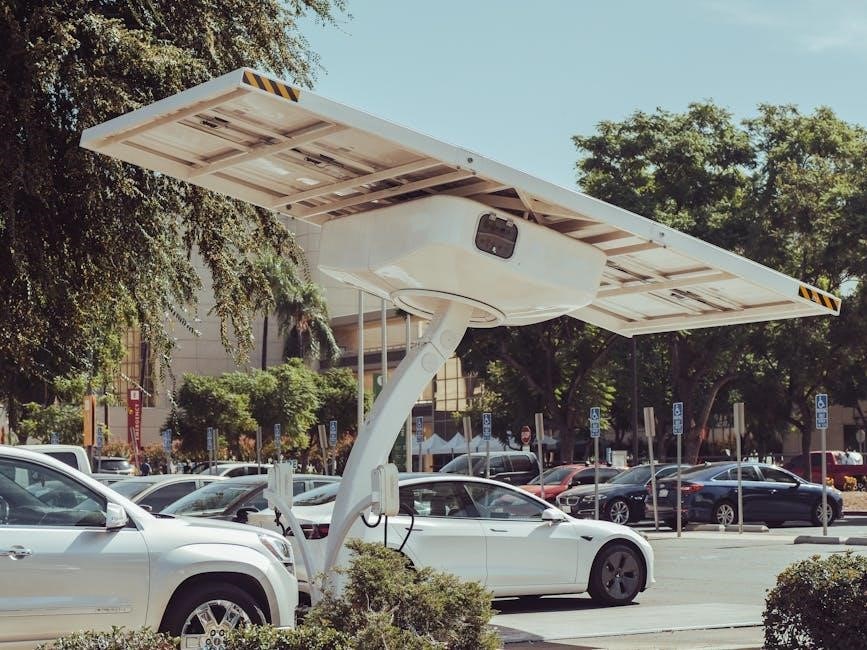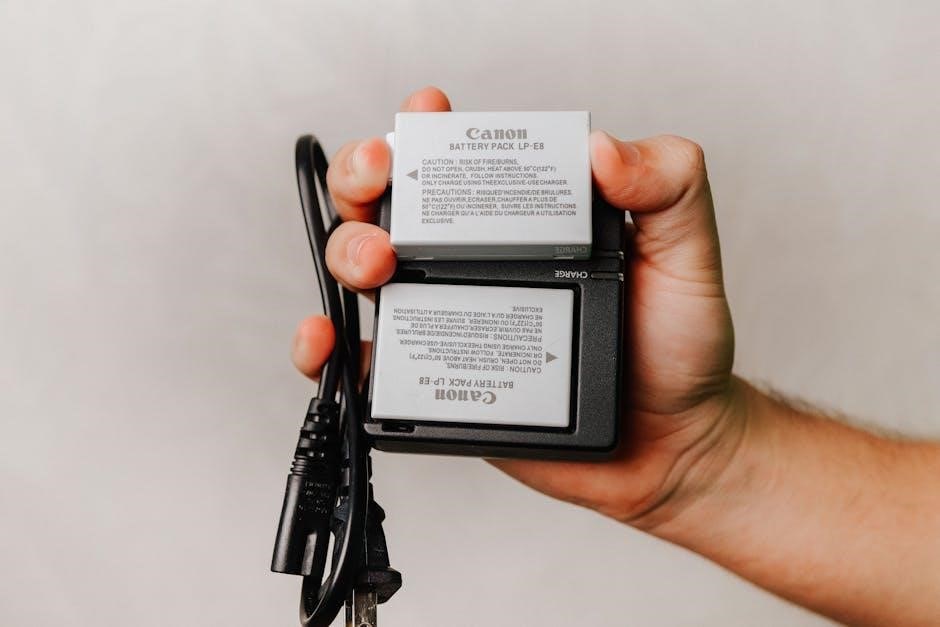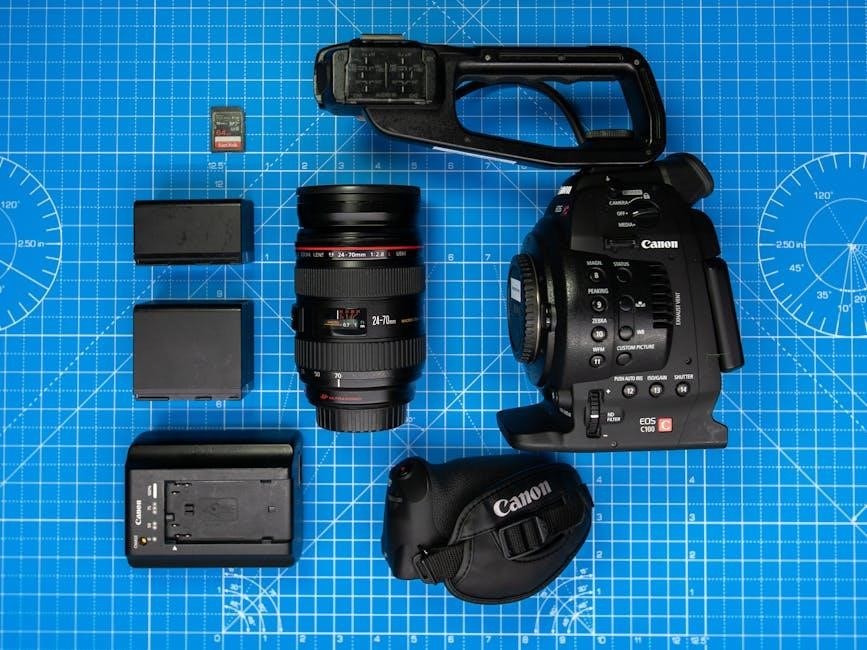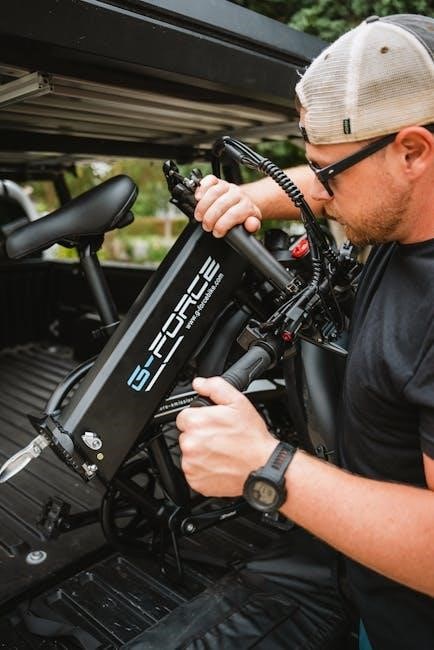quiq battery charger manual
Welcome to the QuiQ Battery Charger Manual, your comprehensive guide to safe and effective operation. This manual provides essential safety, installation, and troubleshooting information for optimal performance and longevity.
1.1 Overview of the QuiQ Battery Charger
The QuiQ Battery Charger is a high-performance charging solution designed for efficient and reliable battery management. It offers advanced charging algorithms to ensure optimal charging cycles, extending battery life and performance. With a user-friendly interface and robust construction, it is suitable for various applications, including industrial equipment, electric vehicles, and renewable energy systems. The charger supports multiple battery types, including lead-acid and lithium-ion, making it versatile for different power needs. Its compact design and smart cooling system enable stable operation in demanding environments.
1.2 Importance of Following the Manual
Following the QuiQ Battery Charger manual is essential for safe and efficient operation. It provides critical guidelines to prevent electrical hazards, ensure proper installation, and maintain optimal performance. Misuse can lead to equipment damage, void warranties, or pose safety risks. Adhering to the manual ensures compliance with safety standards and prolongs the charger’s lifespan. Proper handling of electrical components and battery connections is emphasized to avoid accidents. Always refer to the manual before installation or operation to guarantee reliability and safety.

Safety Guidelines
Adhering to safety guidelines is crucial to prevent hazards and ensure proper handling of the QuiQ charger. Always follow precautions for high voltage, electrical, and battery safety.
2.1 High Voltage Safety
High voltage components can pose serious risks, including electric shock or injury. Always avoid direct contact with live parts. Use insulated tools and ensure proper grounding. Never attempt repairs or adjustments without disconnecting the power source. Wear appropriate personal protective equipment, such as gloves and safety glasses. Keep unauthorized personnel away from high voltage areas. Ensure all safety interlocks are functional before operating the charger. Regularly inspect high voltage cables and connections for damage or wear.
2.2 Electrical Safety Information
Adhere to all electrical safety standards to prevent hazards. Ensure the charger is installed in a well-ventilated, dry environment, away from flammable materials. Avoid overloading circuits, and use the correct gauge of wire for connections. Never operate the charger near water or in humid conditions. Do not modify or tamper with the charger’s electrical components. Always follow the recommended voltage and current ratings. Use properly rated connectors and avoid loose or corroded connections. Keep children and unauthorized individuals away from electrical components.
2.3 Battery Safety Information
Always handle batteries with care to avoid damage. Avoid exposing batteries to extreme temperatures, physical stress, or short circuits. Never dispose of batteries in open flames or puncture them. Ensure the charger is compatible with the battery type to prevent overheating or explosions. Store batteries in a cool, dry place, away from metal objects. Use protective gloves when handling batteries with exposed terminals. Regularly inspect batteries for signs of swelling, leakage, or corrosion. Follow proper charging and discharging cycles to maintain battery health and safety.
2.4 Installation Safety Information
Ensure the charger is installed in a well-ventilated, dry area away from flammable materials. Disconnect power before installation to prevent electric shock. Verify all connections are secure and free from damage. Use proper grounding to avoid electrical hazards. Install the charger on a stable, level surface to prevent tipping. Follow local electrical codes and regulations. Avoid installing in areas with extreme temperatures or humidity. Keep the charger away from direct sunlight and heat sources. Ensure the area is clear of obstructions for proper airflow and maintenance access.
Mechanical Installation
Secure the charger firmly to a stable surface using approved fasteners. Ensure proper alignment and leveling for optimal performance and stability during operation. Maintain clearance for airflow and access.
3.1 Mounting Instructions
Mount the QuiQ battery charger on a flat, stable surface using the provided mounting brackets. Ensure the surface is clean and dry to prevent damage or vibration. Use M8 bolts or equivalent hardware, tightening to the recommended torque of 20-25 Nm. Align the charger evenly to avoid uneven stress. Maintain a minimum clearance of 10 cm around the unit for proper airflow. Consult the installation template for precise hole alignment. Secure the charger firmly to ensure stability and prevent movement during operation. If unsure, consult a certified technician.
3.2 Vibration Considerations
The QuiQ battery charger should be installed in a location with minimal vibration to ensure optimal performance. Use anti-vibration mounts or isolators if the charger is installed in a vehicle or high-vibration environment. Secure the charger firmly to prevent movement. Avoid mounting near heavy machinery or sources of resonance. Regularly inspect the installation to ensure all fasteners remain tight. Proper isolation will reduce wear and tear, prolonging the lifespan of the charger and ensuring reliable operation. Follow the manufacturer’s guidelines for vibration damping materials if necessary.
3.3 Cable Strain and Minimum Bend Radius
To prevent damage and ensure reliable operation, avoid excessive cable strain on the QuiQ battery charger’s connections. Maintain the minimum bend radius specified in the manual to prevent internal wire damage. Secure cables using appropriate clips or ties, ensuring they are not over-tightened. Avoid sharp bends or kinking, as this can compromise the integrity of the cables. Proper cable management will minimize the risk of electrical failures and ensure long-term performance. Always refer to the manufacturer’s guidelines for specific cable handling recommendations.

Electrical Installation
Ensure proper electrical connections for the QuiQ battery charger, adhering to AC input and DC output configurations. Follow safety guidelines and manufacturer recommendations for secure installations;
4.1 AC Input and Connector Details
The QuiQ battery charger requires a compatible AC input source to function. Ensure the charger is connected to a properly grounded AC outlet with the correct voltage and frequency rating. The charger typically accepts standard AC connectors, such as IEC 60320 types, to ensure secure and reliable power delivery. Always verify the input specifications in the manual to avoid damage or malfunction. Proper AC input ensures efficient charging and prevents electrical hazards. Refer to the manual for diagrams and detailed connector compatibility information.
4.2 DC Output Configuration
The QuiQ battery charger provides adjustable DC output settings to match your battery’s requirements. Configure the voltage and current levels using the control panel or software interface. Ensure the output parameters align with the battery’s specifications for optimal charging. The charger supports multiple charging modes, such as constant voltage and constant current. Verify the polarity of the DC output terminals to prevent reverse connections. Refer to the manual for detailed instructions on configuring the DC output for your specific battery type and capacity.
4.3 Interlocks and Wetting Circuit
The QuiQ battery charger features interlocks to ensure safe operation by preventing unintended activation. The wetting circuit is designed to maintain battery health by applying a controlled low-current charge. This helps reduce sulfation and extends battery life. Always ensure the interlocks are properly engaged before use. The wetting circuit operates automatically when the charger is connected to a battery. Consult the manual for specific wiring and activation procedures to ensure proper functionality and safety. Regular inspection of these circuits is recommended.
4.4 Wire Terminations and Fuse Recommendations
Proper wire terminations are crucial for reliable operation. Use high-quality connectors and ensure all connections are secure to avoid resistance issues. For fuses, select ratings that match the charger’s specifications to protect against overcurrent. Tighten terminals to the recommended torque to prevent loosening. Avoid mixing fuse ratings in parallel circuits. Always refer to the manual for specific fuse types and wire gauge recommendations. Proper termination and fuse selection ensure safe and efficient charging. Regularly inspect connections for signs of wear or corrosion. Adhere to these guidelines to maintain optimal performance and safety.

Troubleshooting the QuiQ Charger
Troubleshooting involves identifying and resolving issues with the charger. Common problems include error codes, connection faults, or charging malfunctions. Always refer to the manual for solutions.
5.1 LED Indicators and Fault Codes
The QuiQ Charger features LED indicators to display its operational status and any faults. Green indicates normal operation, while red signals a fault or error. Amber may show charging progress or a warning. Fault codes, such as E01 or E02, are displayed on the charger or connected devices. These codes correspond to specific issues, like overvoltage or communication errors. Always refer to the manual for a detailed list of codes and their meanings. Addressing these issues promptly ensures reliable performance and longevity of the charger and battery system.
5.2 Common Fault Indications
The QuiQ Charger may display common faults related to overvoltage, overheating, or communication errors. These issues often occur due to improper connections, environmental factors, or battery incompatibility. Users may notice reduced charging efficiency or complete shutdown. Always check connections and ensure the battery type matches the charger’s specifications. Refer to the manual for detailed troubleshooting steps. Addressing these faults promptly prevents damage to both the charger and battery system, ensuring safe and reliable operation. Regular maintenance can help minimize such issues.
5.3 Troubleshooting the QuiQ-DCI Charger/Converter
Troubleshooting the QuiQ-DCI involves checking for error codes, ensuring proper connections, and verifying input power. Start by reviewing the LED indicators to identify specific fault codes. Next, inspect all electrical connections for tightness and integrity. Ensure the AC input voltage matches the charger’s specifications. If issues persist, reset the charger by disconnecting power for 30 seconds. For persistent faults, refer to the manual or contact technical support. Always follow safety guidelines when performing diagnostics to avoid potential hazards. Regular checks help prevent recurring problems.

Maintenance and Upkeep
Regular maintenance ensures optimal performance and longevity. Clean the charger, inspect connections, and schedule annual professional checkups. Replace worn parts promptly and update firmware as needed.
6.1 Cleaning and Inspection
Regular cleaning and inspection are crucial for maintaining the QuiQ battery charger’s efficiency and safety. Power off the charger before cleaning. Use a soft, dry cloth to wipe down the exterior, removing dust and dirt. Inspect all cables, connectors, and terminals for signs of wear, corrosion, or damage. Ensure all connections are secure and tighten any loose screws or terminals. Check for any blockages in ventilation openings to prevent overheating. Address any issues promptly to maintain optimal performance and prevent potential hazards. Schedule professional inspections annually for thorough evaluation. Always follow safety guidelines during maintenance tasks.
6.2 Regular Checkups
Perform regular checkups every six months to ensure the QuiQ battery charger operates efficiently. Schedule annual professional inspections to verify internal components and wiring integrity. Check for firmware updates and install them as needed. Monitor battery health and charging performance to detect early signs of decline. Ensure all settings align with the battery type and application. Inspect electrical connections for tightness and corrosion. Keep a maintenance log to track activities and ensure compliance with warranty requirements. Address any anomalies promptly to prevent downtime and ensure reliable operation.
6.3 Updating Firmware (if applicable)
Regularly check for firmware updates to ensure optimal performance and compatibility. Use the QuiQ interface or website to verify availability. Download updates from official sources only to avoid malware. Follow the provided instructions for installation, ensuring the charger is connected to a stable power source. Backup settings before updating, as some configurations may reset. Allow the process to complete without interruption. For advanced models, updates may require a USB drive. Contact support if issues arise during the update process to prevent system corruption.

Operating Instructions
Ensure proper setup and safety before use. Follow pre-operation checks, connect the charger to the battery, and monitor the charging process carefully for optimal performance.
7.1 Pre-Operation Checks
Before operating the QuiQ battery charger, perform essential pre-operation checks. Inspect the charger and battery cables for any visible damage or wear. Ensure the battery is compatible with the charger’s specifications. Verify that the voltage and current settings match the battery requirements. Check that all connections are secure and properly tightened. Also, ensure the surrounding area is clear of flammable materials and well-ventilated. Review the charger’s display for any error messages and confirm the charger is placed on a stable, level surface. Following these steps helps prevent potential issues and ensures safe and efficient charging.
7.2 Connecting the Charger to the Battery
To connect the QuiQ battery charger to the battery, start by ensuring both the charger and battery are turned off. Identify the positive and negative terminals on both the charger and battery, typically marked with “+” and “-” signs or colored red and black, respectively. Attach the charger’s positive cable clamp to the battery’s positive terminal, and the negative cable clamp to the battery’s negative terminal. Ensure the connections are secure and not loose to maintain proper contact. Avoid touching the terminals with bare hands or metal objects to prevent short circuits. Once connected, double-check that the charger is set to the correct voltage and current settings for the specific battery type. This ensures safe and efficient charging. Always refer to the charger’s manual for specific instructions if unsure. Proper connection is vital to prevent damage to both the charger and the battery, and to ensure reliable operation. By following these steps, you can safely and effectively charge your battery using the QuiQ charger.
7.3 Monitoring the Charging Process
Monitoring the charging process is essential to ensure safe and efficient operation. Once the charger is connected to the battery, observe the LED indicators on the charger, which typically display charging status, fault conditions, or completion. Periodically check the charger’s display for voltage, current, and temperature readings. Ensure the charging process progresses smoothly and within the expected time frame. If the charger indicates an error or charging stops unexpectedly, refer to the troubleshooting section. Regular monitoring helps prevent overcharging and maintains battery health. Always follow the recommended charging parameters for optimal performance.
7.4 Disconnecting the Charger
To safely disconnect the charger, first turn off the charger using the power switch. Allow any capacitors to discharge for a few seconds to prevent sparks. Disconnect the battery connector first, ensuring it is securely removed from the terminals. Next, disconnect the AC input cable from the power source. Always handle connectors by the insulated portions to avoid electrical shock. Store the charger and cables neatly to prevent damage. If unsure, consult the manual for specific disconnection procedures for your QuiQ model.

Special Features
The QuiQ battery charger boasts advanced features like DC-DC conversion, lithium charging, and high-efficiency PFC, ensuring optimal performance and versatility for various battery types and applications.
8.1 DC-DC Converter Functionality
The DC-DC converter in the QuiQ battery charger enables efficient voltage conversion, allowing the charger to adapt to various input and output requirements. This feature ensures stable power delivery, enhancing overall charging performance and compatibility with different battery systems. The converter’s high efficiency minimizes energy loss, making the charging process more reliable and consistent. This functionality is crucial for maintaining optimal battery health and ensuring seamless operation across diverse applications.
8.2 Lithium Battery Charging
The QuiQ battery charger is designed to safely charge lithium batteries, offering precise control over voltage and current. It supports various lithium chemistries, including LiFePO4, Li-ion, and Li-polymer. The charger features adaptive charging profiles to optimize performance and longevity. Overcharge protection, thermal monitoring, and cell balancing ensure safe and efficient charging. This functionality makes it ideal for modern energy storage systems, providing reliable power delivery and extending battery life. The charger’s advanced algorithms ensure compatibility with lithium batteries of varying capacities and configurations.
8.3 High-Efficiency Power Factor Correction (PFC)
The QuiQ battery charger incorporates high-efficiency Power Factor Correction (PFC) technology, ensuring optimal energy utilization. PFC minimizes harmonic distortion, improving AC input current quality and reducing energy loss. This feature enhances overall efficiency, stabilizes power supply, and reduces electromagnetic interference. By maintaining a high power factor, the charger operates more efficiently, especially in grid-connected systems. This design meets international energy standards, making it environmentally friendly and suitable for high-performance applications. The PFC technology ensures reliable and efficient charging while maintaining grid stability.

Compliance and Certifications
The QuiQ battery charger meets international safety and efficiency standards, ensuring compliance with environmental regulations for high performance and safe operation.
9.1 IP66 Enclosure Rating
The QuiQ battery charger features an IP66-rated enclosure, ensuring complete protection against dust ingress and powerful water jets from all directions. This robust design ensures reliable operation in harsh environments, including industrial and outdoor settings. The IP66 rating confirms the charger’s durability and resistance to environmental factors, providing users with peace of mind. Regular maintenance is simplified, as the sealed enclosure minimizes contamination risks. This certification underscores the charger’s suitability for demanding applications, ensuring long-term performance and reliability.
9.2 UL2202 Compliance
The QuiQ battery charger is fully compliant with UL2202 standards, ensuring it meets rigorous safety requirements for electric vehicle charging systems. This certification guarantees the charger’s durability, performance, and reliability under various operating conditions. UL2202 compliance verifies that the charger has undergone extensive testing for electrical safety, thermal performance, and mechanical robustness. This certification makes the QuiQ charger suitable for a wide range of applications, reinforcing user trust in its quality and safety. Compliance with UL2202 underscores the charger’s adherence to industry safety protocols.
9.3 Other Relevant Certifications
In addition to UL2202 compliance, the QuiQ battery charger holds other certifications that ensure its reliability and safety. It is CE marked, indicating compliance with European Union directives for health, safety, and environmental protection. The charger also meets ETL certification standards, verifying its adherence to North American safety requirements. Furthermore, it complies with ISO standards for electrical performance and efficiency. These certifications collectively ensure the charger’s suitability for diverse applications, reinforcing its quality and adherence to global safety and performance benchmarks.

Accessories and Replacement Parts
The QuiQ charger offers a range of accessories, including compatible connectors, cables, and adapters, ensuring seamless integration and enhanced functionality for various applications and systems.
10.1 Compatible Connectors and Cables
The QuiQ battery charger supports a variety of connectors and cables designed for seamless integration. Ensure compatibility by using QuiQ-approved connectors to maintain performance and safety. High-quality cables with proper gauge ratings are essential for efficient power transfer. Refer to the compatibility list in the manual or contact your supplier for verified options. Using non-compatible connectors may lead to reduced efficiency or potential damage. Always opt for IP66-rated cables for durability in harsh environments. Proper connections ensure reliable charging and system longevity.
10.2 Available Kits and Adapters
QuiQ offers a range of accessory kits and adapters to enhance functionality and adaptability. These include mounting kits for secure installation, cable kits for extended reach, and adapter plugs for compatibility with various battery types. Additional adapters enable integration with specific voltage requirements or connectors. For detailed specifications, refer to the QuiQ parts catalog or contact authorized distributors. These accessories ensure optimal performance and flexibility, catering to diverse charging needs across applications. Proper use of kits and adapters guarantees efficient and reliable operation of the charger system. Always verify compatibility before installation.
10.3 Part Numbers for Reference
For easy identification and ordering, QuiQ provides specific part numbers for all components and accessories. These part numbers are listed in the official QuiQ documentation and are essential for ensuring compatibility and authenticity. Users should refer to the provided catalog or contact authorized dealers for accurate part number lookup. Incorrect or mismatched parts can void warranties or lead to operational issues. Always verify part numbers with QuiQ’s official resources before making a purchase or performing maintenance. This ensures compliance with safety and performance standards.

Warranty and Support
The QuiQ Battery Charger is backed by a comprehensive warranty program, ensuring protection against defects in materials and workmanship. Dedicated customer support is available for troubleshooting, repairs, and general inquiries, providing users with reliable assistance to maintain optimal performance and address any issues promptly.
11.1 Warranty Terms and Conditions
The QuiQ Battery Charger is covered by a 24-month limited warranty from the date of purchase. This warranty covers defects in materials and workmanship under normal use and conditions; Damage caused by misuse, accidents, or unauthorized modifications is not covered. Warranty claims require proof of purchase and must be submitted within the warranty period. Repairs or replacements are at the manufacturer’s discretion. Registration of the product is recommended for warranty validation, though not mandatory. For full details, refer to the warranty agreement provided with the charger.
11.2 Contacting Customer Support
For assistance with the QuiQ Battery Charger, contact customer support via phone at +1-800-QUIQBATTERY or email at support@quiqchargers.com. Visit the official website for live chat and online support ticket submissions. Support is available 24/7 for urgent inquiries. Include your product serial number and a detailed description of your issue for faster resolution. Refer to the contact page for regional contact information and operating hours. Ensure to use official support channels for genuine assistance and to avoid unauthorized representatives.
11.4 Online Resources and Documentation
Access comprehensive online resources and documentation for the QuiQ Battery Charger on the official QuiQ website. Download user manuals, troubleshooting guides, and technical specifications in PDF format. Explore FAQs, installation tutorials, and software updates. The support portal offers detailed articles and videos to assist with charger setup and maintenance. Registered users can also access exclusive materials and updates to ensure optimal performance and compliance with safety standards.
The QuiQ Battery Charger Manual guides users to ensure safe, efficient, and optimal charging experiences. By following the outlined procedures, users can maximize battery performance and longevity.
12.1 Final Tips for Optimal Performance
For optimal performance, regularly inspect and clean the charger to ensure proper airflow. Always monitor charge levels and avoid overcharging. Use genuine QuiQ accessories to maintain compatibility and safety. Adjust settings according to battery type for efficient charging. Store batteries in a cool, dry place when not in use. Keep the charger firmware updated for enhanced functionality. By following these tips, users can extend the lifespan of both the charger and batteries while ensuring reliable operation.
12.2 Importance of Proper Usage and Maintenance
Proper usage and maintenance are critical for ensuring the longevity and efficiency of the QuiQ Battery Charger. Neglecting routine checks can lead to reduced performance or even safety hazards. Always adhere to the guidelines outlined in this manual to prevent electrical or battery damage. Timely maintenance ensures reliable operation and extends the lifespan of both the charger and batteries. By prioritizing proper care, users can avoid costly repairs and ensure consistent, optimal performance over time.

